- Home
- Robert Silverberg
Gilgamesh the King
Gilgamesh the King Read online
PRAISE FOR THE WRITING OF ROBERT SILVERBERG
“Nightwings is Robert Silverberg at the top of his form, and when Silverberg is at the top of his form, no one is better. A haunting, evocative look at a crumbling Earth of the far future and a human race struggling to survive amidst the ruins, full of memorable characters and images that will long linger in your memory, this is one of the enduring classics of science fiction.” —George R. R. Martin
“No matter if Silverberg is dealing with material that is practically straight fiction, or going way into the future … his is the hand of a master of his craft and imagination.” —Los Angeles Times
“The John Updike of science fiction.” —The New York Times Book Review
“What wonders and adventures he has to tell us.” —Ursula K. Le Guin
“He is a master.” —Robert Jordan
“One of the very best.” —Publishers Weekly
“In the field of science fiction, Silverberg occupies a place in the highest echelon. His work is distinguished by elegance of style, intellectual precision, and far-reaching imagination.” —Jack Vance
“When one contemplates Robert Silverberg it can only be with awe. In terms of excellence he has few peers, if any.” —Locus
“Robert Silverberg is our best … Time and time again he has expanded the parameters of science fiction.” —The Magazine of Fantasy and Science Fiction
Gilgamesh the King
Robert Silverberg
This is Diana’s book
Contents
Introduction
1
2
3
4
5
6
7
8
9
10
11
12
13
14
15
16
17
18
19
20
21
22
23
24
25
26
27
28
29
30
31
32
33
34
35
36
37
38
39
40
41
Afterword
A Biography of Robert Silverberg
INTRODUCTION
I’ve been a passionate armchair archaeologist since my encounter, at the age of nine, with Anne Terry Wright’s book Lost Worlds, which told tales of the wondrous lost civilizations of Troy, Crete, Egypt, Assyria, Babylonia, and the Mayan lands of Mexico, and their rediscovery by such great explorers as Heinrich Schliemann, Sir Arthur Evans, and Austen Henry Layard. My first taste of romantic antiquity led me to venture deeper and deeper into archaeological investigations, through such books as C. W. Ceram’s Gods, Graves & Scholars and Sir Leonard Woolley’s Digging Up the Past, and, eventually, through the books in which archaeologists described their own investigations.
In the course of all that reading—and in the writing of my own books on archaeological subjects, which began with my Lost Cities and Vanished Civilizations (1962)—I came across the ancient Sumerian tale of Gilgamesh. Here, my interest in archaeology meshed with my even stronger interest in science fiction, for it is possible to claim that the ancient Gilgamesh legend is in fact the oldest known science-fiction story.
The clay tablets containing the legend of Gilgamesh turned up in the middle of the nineteenth century, during the excavation by the British archaeologist Austen Henry Layard of the palace of the ancient Assyrian king Sennacherib at Mosul, in what is now Iraq. It was years before the cuneiform script of Assyria could be deciphered and translated; but in 1872, George Smith, a British Museum philologist who was sorting through the vast hoard of tablets from the library of Sennacherib’s palace, came upon part of an inscription that told the legend of a great flood, very much like the biblical deluge of Noah. Quickly rummaging through the great mass of tablets, he found other pieces of the tale. Perhaps, he thought, the rest of the story lay buried somewhere in the great Assyrian mound at Mosul. Aware of the importance of uncovering the text of an Assyrian myth that paralleled the biblical account, Smith persuaded a British newspaper to underwrite the cost of an expedition to Mesopotamia so that he could look for it.
He arrived in Mosul in May, hired some workmen, and began digging in the part of Sennacherib’s palace that Layard had referred to as the “chambers of record.” At once he began to uncover inscribed tablets, thousands of them, and—implausibly, miraculously—on the fifth day of work found what he had come to find: a tablet “that contained the greater portion of the seventeen lines of inscription belonging to the first column of the Chaldean [Mesopotamian] account of the Deluge, and fitting into the only place where there was a serious blank in the story.”
When he returned to England, Smith produced a translation—a preliminary one, full of errors, for the decipherment of cuneiform tablets was still only an approximate science then—of this tale of an Assyrian Noah, Utnapishtim by name: “All that I possessed of the seed of life I gathered together, the whole I made to enter into the ship, all my servants, male and female, the tame animals of the fields, and the wild animals of the plains. … And Shamash [the god of the sun] caused a great flood, and he spake, speaking in the darkness of the night: ‘I will cause it to rain from the heavens abundantly; enter within the ship and close the door.’ … The waters destroyed all life from the face of the earth. … I was borne over the sea. Those who had done wickedness, all the human race who had turned to sin—the bodies of these floated like reeds. … ” All the rest is there, too, the landing of the Ark atop a great mountain, the sending to bring back information about the state of things in the world, the eventual emergence from the ship, and the resettlement of the Earth by the survivors of the great flood.
Smith’s book stirred up a great furor—were the tales the Bible told nothing more than rewrites of Assyrian myths?—and soon archaeologists working in the Mesopotamian mounds unearthed other copies of the Deluge text. It became clear that the version in Sennacherib’s library, which dated from about 700 B.C., was an Assyrian translation of a much older text—perhaps two thousand years older—in the language of the Sumerians, the founders of the first Mesopotamian civilization. Since the Bible text we have could not be any older than about 1300 B.C., this Sumerian myth must have been in circulation in the Mesopotamian region for at least a thousand years when the earliest text of Genesis was written.
It also turned out that the flood myth contained in those Assyrian and Sumerian tablets was part of a larger epic involving the adventures of an ancient hero named Gilgamesh, who was king of the Mesopotamian city of Uruk, and something like Hercules and Odysseus rolled into one. This titanic figure, who claimed to be two parts god and only one part mortal, couples with goddesses, slays monsters and demons, and, after trying and failing to prevent the death of his beloved friend Enkidu, feels a great anger at the thought that he too must ultimately die, and sets out across the world on a quest for the secret of eternal life. That secret, he learns in a divinely induced vision, can be obtained from the hero of the Deluge story, Ziusudra (as the Noah-figure is known in the Sumerian version of the text), who lives on the blessed isle of Dilmun somewhere far to the south. It is at this point that the Gilgamesh epic pauses to retell the tale of Ziusudra, whom the gods chose to spare when they grew weary of sinful mankind and sent a great flood to drown the world.
Gilgamesh’s quest for immortality takes him, after many an adventure, to Dilmun, and then to the nameless island nearby that is Ziusudra’s actual home. There, the anc
ient patriarch heads a community of holy men and women who live in monastic simplicity; and after several interviews in which Gilgamesh speaks of his fear of death, Ziusudra tells him where to find the plant known as Grow-Young-Again, from the pearl-like fruit of which he can make a drug that will reverse the ravages of age.
Alas, there is to be no immortality for Gilgamesh. He obtains the fruit of Grow-Young-Again, but loses it before he can prepare his immortality serum, thus fulfilling a prophecy he had heard on his journey: Gilgamesh, you never will find this eternal life that you seek. Returning to Uruk, he takes up the responsibilities of kingship again, reconciled at last to the knowledge that, one day, death will come to him as it does for all other men.
It seemed to me, after reading the complete text of the Gilgamesh epic—nearly all of it has been recovered by now, and many translations are available—that this must be the earliest science-fiction story still in existence, for surely the tale of a quest for an immortality serum qualifies as science fiction. Just about every science-fiction writer has tackled the theme in one fashion or another, among them Robert A. Heinlein in Methuselah’s Children (1941), A. E. van Vogt in The Weapon Makers (1943), Jack Vance in To Live Forever (1956), and Wilson Tucker in The Time Masters (1953), which brought the actual immortal Gilgamesh into the twentieth century. And, of course, many writers from the world of mainstream literature have dealt with the theme: George Bernard Shaw in Back to Methuselah (1921), Karel Čapek in The Makropolous Secret (1922), Aldous Huxley in After Many a Summer Dies the Swan (1939), and a multitude of others.
In 1972, I had written an immortality novel of my own, The Book of Skulls. By then, I had had for many years, tucked away in the back of my mind, the notion of doing a book that retold the Gilgamesh legend, not as melodramatic science fiction of the sort Tucker had written, nor as a fantasy full of evil priests and magic spells, but simply as a historical novel with no fantastic or supernatural elements: the story of Gilgamesh, the king of Uruk, in the land of Sumer nearly five thousand years ago, telling—in his own words—how he came into his kingship and how he struggled against the knowledge that one day he would have to die.
It was not until 1983 that I actually did anything about it. My publisher then was Arbor House, a mid-sized company run by the dynamic, aggressive, irascible Donald I. Fine. How Arbor House had come to be my publisher then is almost a book-length saga in itself; suffice it to say that in 1980, Fine had executed an intricate publishing maneuver that to my great surprise, and that of my agent, had swept me away from my publisher at the time and turned me into an Arbor House writer. But I had quickly discovered that, although he had a well-deserved reputation for being a difficult character, he would treat me with much tenderness and respect, and right from the outset we developed a warm and mutually rewarding relationship.
We did four books together over the next three years. Then, in a letter to Fine dated July 14, 1983, I proposed Gilgamesh the King as my next Arbor House book, explaining that
“the Sumerian legend of Gilgamesh is the world’s oldest surviving work of great literature, dating back more than five thousand years—which makes it nearly twice as old as The Iliad and The Odyssey. Gilgamesh is the first tragic hero of whom we know anything, and the myths that grew up about him have spread so widely through the folklore of later peoples that they may be ancestral to much of the heroic romance and mythology of other cultures, from the Homeric Greeks down to the medieval fantastists.”
The historical Gilgamesh, I explained, was the fifth king of the Sumerian city of Uruk, living somewhere about 3000 B.C. After his death, a cluster of hero-legends sprang up about him, which became the subject of the epic tale that remained current and popular throughout thousands of years of Sumerian, Assyrian, and Babylonian life. I summarized the episodes of the epic scene by scene, concluding with his failed quest for the potion of immortality and his reconciliation with the inevitability of his own death. “What I want to do,” I said, “is use this myth as the skeleton for a first-person novel of some 400 manuscript pages that would be, essentially, the memoirs of Gilgamesh: a book in which he tells of his life in straightforward, matter-of-fact prose, describing his rise to power, his adventures, his obsession with immortality, and his ultimate realization that it cannot be obtained. … This narrative will play out against a detailed background of life in Sumer, the world’s first civilized nation. That is, instead of being a romantic tale of demons and monsters and magic, it will be a human story—the best model for which, I think, is Mary Renault’s The King Must Die, in which she turns the legends of Theseus into a plausible and convincing account of one man’s life in pre-Homeric Greece.”
The book, I thought, would have a crossover audience, attracting the readers of serious historical novels, while the aspect of extreme antiquity and the tinge of heroic fantasy would bring in the fantasy/science-fiction audience where my name was already well known. Don Fine agreed, and, after some months of research, I began writing the book late in 1983, delivering it in the spring of 1984. Arbor House published it that fall.
Finding readers for it, though, proved more complicated than I had anticipated. The way books were sold in those days—only through bookstores; the Internet did not yet exist—resulted in rigid compartmentalization of categories. Science-fiction books were displayed in one section of a bookstore, fantasy novels in another, and historical novels somewhere else entirely. Any book bearing the byline of Robert Silverberg, who had been publishing mostly science fiction under that name since 1955, would automatically wind up in the s-f section, among the Foundation novels of Isaac Asimov, and the Dune novels of Frank Herbert, and 2001 and its various sequels by Arthur C. Clarke. But Gilgamesh the King didn’t have much in common with those works.
Of course, I was hoping for a crossover audience. But not only was that a problem for someone as firmly rooted in science fiction as I was, but the readership I wanted to cross over into turned out to be a vanishing one. “I think we should make every effort to go after the Mary Renault audience (i.e., the audience for intelligent non-bodice-ripper historical novels) in marketing the book,” I told the Arbor House marketing chief. But what I didn’t know was that “the audience for intelligent, non-bodice-ripper historical novels” had virtually collapsed by the early 1980s, and that the books of Mary Renault herself, bestsellers in their day, were no longer doing very well. It might not have been easy for a writer like me, with a long-established name in an entirely different field of fiction, to break into that market at all; but the market itself, I discovered, had greatly dwindled by the time I was attempting to enter it.
My reputation as a science-fiction writer assured that the book would be displayed in the s-f section, anyway. Since the book, lacking as it was in spaceships, robots, time machines, alien beings, and the rest of the conventional furniture of science fiction, didn’t look or feel like science fiction, s-f readers who picked it up and skimmed through it in the bookstores very likely would put it down again without buying it. I could argue all I liked that a novel that dealt with a quest for immortality was examining one of the great science-fiction themes; but the readers wouldn’t agree. On the other hand, some readers of heroic fantasy might go for it, but I had no particular reputation as a writer of heroic fantasy, and, besides, I had taken some pains to rationalize away the more implausibly fantastic elements of the legend, so, in its way, the book was more a novel of anti-fantasy than anything else. That made it unlikely to build a word-of-mouth audience among fantasy readers. And so, falling between genres, Gilgamesh the King went almost unnoticed in its day.
But that day was long ago, and though bookstores and their rigid categories still exist, we now have the Internet and its new methods for distributing books; and here is my Gilgamesh novel again for modern readers. Is it a historical novel? Science fiction? Fantasy? That doesn’t really matter. What it is, is a work of fiction, a book that retells the oldest myth known to humanity in a modern tone of voice. Gilgamesh the king is five thousa
nd years old and, just as he desired so keenly, will never die, because his story is such a powerful one; and perhaps now Gilgamesh the King, the novel and not the hero, will find its place in the world also.
—Robert Silverberg
1
THERE IS IN URUK THE city a great platform of kiln-baked brick that was the playing field of the gods, long before the Flood, in that time when mankind had not yet been created and they alone inhabited the Earth. Every seventh year for the past ten thousand years we have painted the bricks of that platform white with a plaster of fine gypsum, so that it flashes like a vast mirror under the eye of the sun.
The White Platform is the domain of the goddess Inanna, to whom our city is consecrated. Many of the kings of Uruk have erected temples upon the platform for her use; and of all these shrines of the goddess none was more grand than the one that was built by my royal grandfather the hero Enmerkar. A thousand artisans labored for twenty years to construct it, and the ceremony of its dedication lasted eleven days and eleven nights without cease, and during that time the moon was wrapped each evening in a deep mantle of blue light as a token of Inanna’s pleasure. “We are Inanna’s children,” the people sang, “and Enmerkar is her brother, and he shall reign forever and ever.”
Nothing remains of that temple now, for I tore it down after I came to the throne, and put up a far more splendid one on its site. But in its time it was a wonder of the world. It is a place that will always hold special meaning for me: within its precincts, one day in my childhood, the beginnings of wisdom descended on me, and the shape of my life was shaped, and I was set upon a course from which there has been no turning.
That was the day on which the palace servants fetched me from my games to watch my father the king, divine Lugalbanda, embark upon the last of his journeys. “Lugalbanda goes forth now to the bosom of the gods,” they told me, “and he shall live for all time among them in joy, and drink their wine and eat their bread.” I think and hope that they were right; but it may very well be the case that my father’s final journey has brought him instead to the Land of No Returning, to the House of Dust and Darkness, where his ghost shuffles about sadly like a bird with crippled wings, feeding on dry clay. I do not know.

 The Longest Way Home
The Longest Way Home Hawksbill Station
Hawksbill Station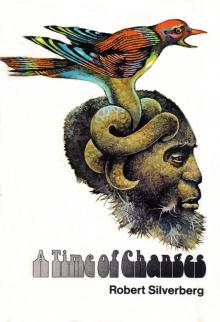 A Time of Changes
A Time of Changes This Way to the End Times: Classic Tales of the Apocalypse
This Way to the End Times: Classic Tales of the Apocalypse Beyond the Gate of Worlds
Beyond the Gate of Worlds Lord Valentine's Castle
Lord Valentine's Castle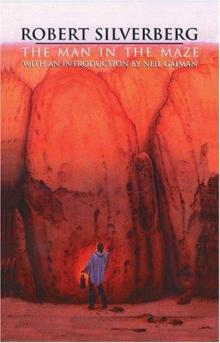 The Man in the Maze
The Man in the Maze Tales of Majipoor
Tales of Majipoor Time of the Great Freeze
Time of the Great Freeze The Collected Stories of Robert Silverberg, Volume 3: Something Wild Is Loose: 1969-72
The Collected Stories of Robert Silverberg, Volume 3: Something Wild Is Loose: 1969-72 Planet of Death
Planet of Death Trips: The Collected Stories of Robert Silverberg, Volume Four
Trips: The Collected Stories of Robert Silverberg, Volume Four In the Beginning: Tales From the Pulp Era
In the Beginning: Tales From the Pulp Era Hot Sky at Midnight
Hot Sky at Midnight Valentine Pontifex
Valentine Pontifex Up the Line
Up the Line Thorns
Thorns Amanda and the Alien
Amanda and the Alien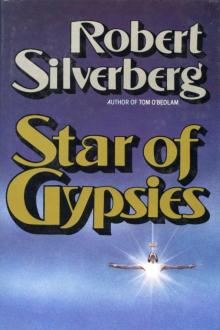 Star of Gypsies
Star of Gypsies Nightwings
Nightwings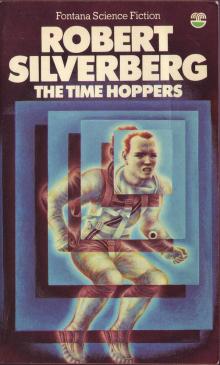 The Time Hoppers
The Time Hoppers Blood on the Mink
Blood on the Mink Dying Inside
Dying Inside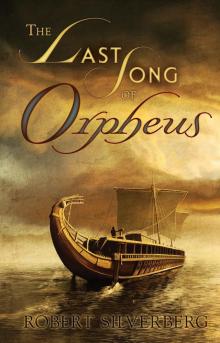 The Last Song of Orpheus
The Last Song of Orpheus The King of Dreams
The King of Dreams The Stochastic Man
The Stochastic Man The Collected Stories of Robert Silverberg, Volume Seven: We Are for the Dark
The Collected Stories of Robert Silverberg, Volume Seven: We Are for the Dark The Millennium Express: The Collected Stories of Robert Silverberg, Volume Nine
The Millennium Express: The Collected Stories of Robert Silverberg, Volume Nine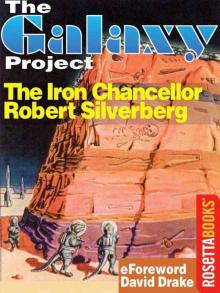 The Iron Chancellor
The Iron Chancellor Lord Prestimion
Lord Prestimion To Open the Sky
To Open the Sky The World Inside
The World Inside Chains of the Sea
Chains of the Sea The Collected Stories of Robert Silverberg, Volume Five: The Palace at Midnight
The Collected Stories of Robert Silverberg, Volume Five: The Palace at Midnight Postmark Ganymede
Postmark Ganymede The Second Trip
The Second Trip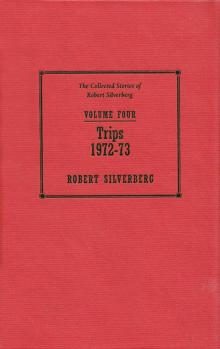 The Collected Stories of Robert Silverberg, Volume 4: Trips: 1972-73
The Collected Stories of Robert Silverberg, Volume 4: Trips: 1972-73 Son of Man
Son of Man Tom O'Bedlam
Tom O'Bedlam To the Land of the Living
To the Land of the Living To Be Continued: The Collected Stories of Robert Silverberg, Volume One
To Be Continued: The Collected Stories of Robert Silverberg, Volume One Shadrach in the Furnace
Shadrach in the Furnace The Chalice of Death: Three Novels of Mystery in Space
The Chalice of Death: Three Novels of Mystery in Space The Queen of Springtime
The Queen of Springtime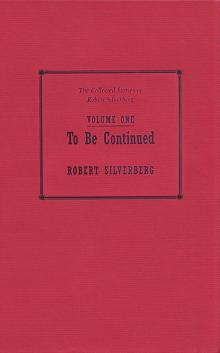 To Be Continued 1953-1958
To Be Continued 1953-1958 Legends
Legends Roma Eterna
Roma Eterna To Live Again
To Live Again At Winter's End
At Winter's End Needle in a Timestack
Needle in a Timestack To Live Again and the Second Trip: The Complete Novels
To Live Again and the Second Trip: The Complete Novels Lord of Darkness
Lord of Darkness The Mountains of Majipoor
The Mountains of Majipoor The World Outside
The World Outside The Alien Years
The Alien Years The Book of Skulls
The Book of Skulls The Face of the Waters
The Face of the Waters Gilgamesh the King
Gilgamesh the King The Collected Stories of Robert Silverberg, Volume 6: Multiples: 1983-87
The Collected Stories of Robert Silverberg, Volume 6: Multiples: 1983-87 The Happy Unfortunate
The Happy Unfortunate Three Survived
Three Survived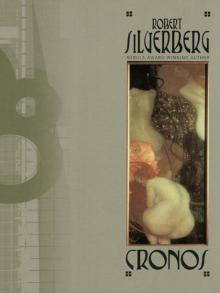 Cronos
Cronos Tower of Glass
Tower of Glass Legends II
Legends II The Planet Killers
The Planet Killers The Collected Stories of Robert Silverberg, Volume 2: To the Dark Star: 1962-69
The Collected Stories of Robert Silverberg, Volume 2: To the Dark Star: 1962-69 Downward to the Earth
Downward to the Earth Lord Valentine's Castle: Book One of the Majipoor Cycle
Lord Valentine's Castle: Book One of the Majipoor Cycle Hot Times in Magma City, 1990-95
Hot Times in Magma City, 1990-95 Hunt the Space-Witch! Seven Adventures in Time and Space
Hunt the Space-Witch! Seven Adventures in Time and Space Majipoor Chronicles
Majipoor Chronicles The Robert Silverberg Science Fiction Megapack(r)
The Robert Silverberg Science Fiction Megapack(r) Starman's Quest
Starman's Quest Car Sinister
Car Sinister Worlds of Maybe
Worlds of Maybe Fantasy The Best of 2001
Fantasy The Best of 2001 Revolt on Alpha C
Revolt on Alpha C Homefaring
Homefaring The Pardoner's Tale
The Pardoner's Tale Sailing to Byzantium - Six Novellas
Sailing to Byzantium - Six Novellas The Chalice of Death
The Chalice of Death Sundance
Sundance A Tip on a Turtle
A Tip on a Turtle Nebula Awards Showcase 2001: The Year's Best SF and Fantasy Chosen by the Science Fiction and Fantasy Writers of America
Nebula Awards Showcase 2001: The Year's Best SF and Fantasy Chosen by the Science Fiction and Fantasy Writers of America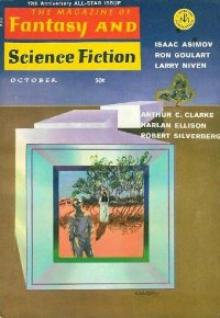 The Fangs of the Trees
The Fangs of the Trees The Palace at Midnight: The Collected Work of Robert Silverberg, Volume Five
The Palace at Midnight: The Collected Work of Robert Silverberg, Volume Five The Millennium Express - 1995-2009 - The Collected Stories of Robert Silverberg Volume Nine
The Millennium Express - 1995-2009 - The Collected Stories of Robert Silverberg Volume Nine Book of Skulls
Book of Skulls Passengers
Passengers Something Wild is Loose - 1969–72 - The Collected Stories of Robert Silverberg Volume Three
Something Wild is Loose - 1969–72 - The Collected Stories of Robert Silverberg Volume Three Multiples
Multiples Starborne
Starborne The Masks of Time
The Masks of Time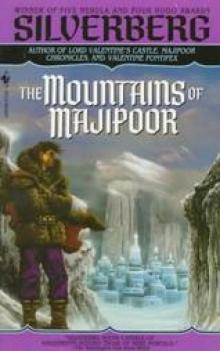 The Mountains of Majipoor m-8
The Mountains of Majipoor m-8 Multiples (1983-87)
Multiples (1983-87) Those Who Watch
Those Who Watch In the Beginning
In the Beginning Earth Is The Strangest Planet
Earth Is The Strangest Planet Collision Course
Collision Course Neutral Planet
Neutral Planet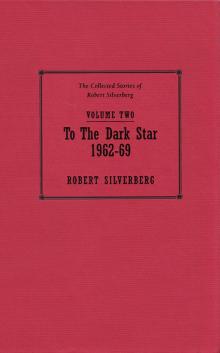 To the Dark Star - 1962–69 - The Collected Stories of Robert Silverberg Volume Two
To the Dark Star - 1962–69 - The Collected Stories of Robert Silverberg Volume Two Mutants
Mutants Sailing to Byzantium
Sailing to Byzantium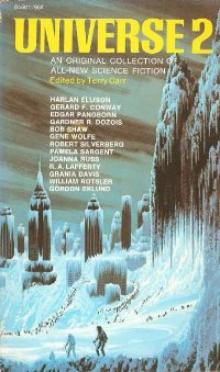 When We Went to See the End of the World
When We Went to See the End of the World Robert Silverberg The Science Fiction Hall Of Fame Volume One, 1929-1964
Robert Silverberg The Science Fiction Hall Of Fame Volume One, 1929-1964 To Be Continued - 1953–58 - The Collected Stories of Robert Silverberg Volume One
To Be Continued - 1953–58 - The Collected Stories of Robert Silverberg Volume One Valentine Pontifex m-3
Valentine Pontifex m-3 Gianni
Gianni Majipoor Chronicles m-2
Majipoor Chronicles m-2 We Are for the Dark (1987-90)
We Are for the Dark (1987-90) Waiting for the Earthquake
Waiting for the Earthquake Fantasy: The Best of 2001
Fantasy: The Best of 2001 How It Was When the Past Went Away
How It Was When the Past Went Away Beauty in the Night
Beauty in the Night The Man Who Never Forgot
The Man Who Never Forgot The Book of Changes m-9
The Book of Changes m-9 Lord Valentine's Castle m-1
Lord Valentine's Castle m-1 This Way to the End Times
This Way to the End Times Queen of Springtime
Queen of Springtime Legends-Volume 3 Stories by the Masters of Modern Fantasy
Legends-Volume 3 Stories by the Masters of Modern Fantasy The Palace at Midnight - 1980–82 - The Collected Stories of Robert Silverberg Volume Five
The Palace at Midnight - 1980–82 - The Collected Stories of Robert Silverberg Volume Five Something Wild is Loose: The Collected Stories of Robert Silverberg, Volume Three
Something Wild is Loose: The Collected Stories of Robert Silverberg, Volume Three Multiples - 1983–87 - The Collected Stories of Robert Silverberg Volume Six
Multiples - 1983–87 - The Collected Stories of Robert Silverberg Volume Six Alaree
Alaree Three Survived: A Science Fiction Novel
Three Survived: A Science Fiction Novel Defenders of the Frontier
Defenders of the Frontier The New Springtime
The New Springtime We Are for the Dark - 1987–90 - The Collected Stories of Robert Silverberg Volume Seven
We Are for the Dark - 1987–90 - The Collected Stories of Robert Silverberg Volume Seven The Science Fiction Hall of Fame, Volume One 1929-1964--The Greatest Science Fiction Stories of All Time Chosen by the Members of the Science Fiction Writers of America
The Science Fiction Hall of Fame, Volume One 1929-1964--The Greatest Science Fiction Stories of All Time Chosen by the Members of the Science Fiction Writers of America Master Of Life And Death
Master Of Life And Death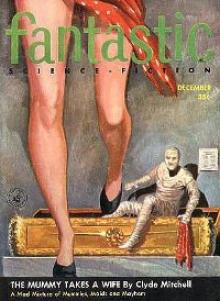 Choke Chain
Choke Chain Sorcerers of Majipoor m-4
Sorcerers of Majipoor m-4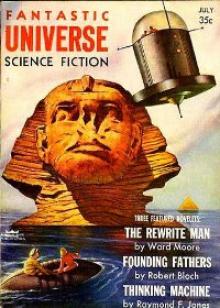 Absolutely Inflexible
Absolutely Inflexible Trips - 1962–73 - The Collected Stories of Robert Silverberg Volume Four
Trips - 1962–73 - The Collected Stories of Robert Silverberg Volume Four Hot Times in Magma City - 1990-95 - The Collected Stories of Robert Silverberg Volume Eight
Hot Times in Magma City - 1990-95 - The Collected Stories of Robert Silverberg Volume Eight Far Horizons
Far Horizons The Queen of Springtime ns-2
The Queen of Springtime ns-2 The Seventh Science Fiction Megapack
The Seventh Science Fiction Megapack Invaders From Earth
Invaders From Earth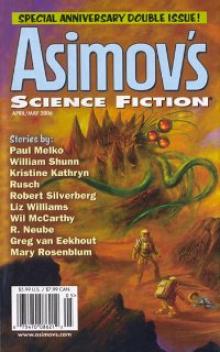 Hanosz Prime Goes To Old Earth
Hanosz Prime Goes To Old Earth The Macauley Circuit
The Macauley Circuit Science Fiction: The Best of 2001
Science Fiction: The Best of 2001 To the Dark Star: The Collected Stories of Robert Silverberg, Volume Two
To the Dark Star: The Collected Stories of Robert Silverberg, Volume Two Stochastic Man
Stochastic Man Legends: Stories By The Masters of Modern Fantasy
Legends: Stories By The Masters of Modern Fantasy To Live Again And The Second Trip
To Live Again And The Second Trip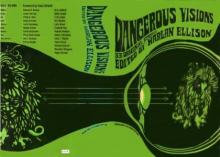 Flies
Flies The Silent Invaders
The Silent Invaders Ship-Sister, Star-Sister
Ship-Sister, Star-Sister